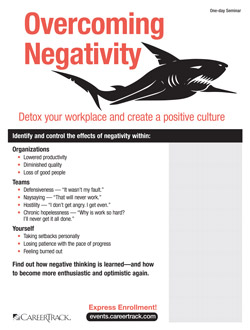Detox your workplace and create a positive culture
Identify and control the effects of negativity within:
- Organizations
- Lowered productivity
- Diminished quality
- Loss of good people
- Teams
- Defensiveness — “It wasn’t my fault.”
- Naysaying — “That will never work.”
- Hostility — “I don’t get angry – I get even.”
- Chronic hopelessness — “Why work so hard? I’ll never get it all done.”
- Yourself
- Taking setbacks personally
- Losing patience with the pace of progress
- Feeling burned out
Find out how negative thinking is learned — and how to become more enthusiastic and optimistic again.
Takeaways for Individuals and Teams Dealing With Workplace Negativity
- Recognize what a positive workplace looks and feels like.
- Uncover the origins of workplace negativity and learn how to arrest its spread in your division, department or team.
- Understand what makes negative people behave the way they do — and what can be done to help them change.
- Acquire skills to blunt the effect of negative coworkers and even reverse their attitudes.
- Recognize negativity in yourself (in all areas of your life), and find ways to be positive and optimistic.
- Learn about “traveling negativity” and the steps to prevent it.
- Thrive and survive in a negative work environment while protecting yourself from other’s sour attitudes.

Detox your workplace and create a positive culture
Negativity is often the underlying cause of underperformance, deteriorating quality and a falloff in teamwork. Those lucky enough to work in an organization that encourages positivity know what aspects it incorporates. For others, this session introduces those characteristics such as open communication, work-life balance and training and development.
Download BrochureWhat is negativity and is it contagious?
- Why some people are so negative — while others are always upbeat
- The toll that “downers” take on the performance, productivity and job satisfaction
- The difference between healthy and harmful skeptics
- Ways people get stuck in a negativity rut:
- Through perceptions (your brain unconsciously reads certain stimuli and triggers a negative reaction)
- Through internal explanations (taking things too personally leads to negativity)
- Through personal beliefs (the less rigid you are in your beliefs, the easier it is to change negative habits)
- The “wrong side of the bed” syndrome — why some days start out lousy and get worse
- How negativity can spread to epidemic proportions — and five steps to arrest it early
- The correlation of self-esteem and negativism (see how elevating one diminishes the other)
- How to find the right balance between optimism and pessimism
- The source of negativity: Is habitual naysaying a trait you’re born with — or is it acquired?
How to deal with negativity between individuals
- “Traveling negativity” — unloading the baggage we carry back and forth between home and work
- Specific remedies to correct negative attitudes and outlooks
- How to sidestep negativity traps set by coworkers
- Why some people enjoy being negative
- The pros and cons of intervention — when it pays to step in, when it doesn’t
- Do others perceive you as negative? Four ways you can alter that perception
- How to deal with specific negative behavior among your employees
- How to work with perpetual skeptics
- Do you “act upon” or “react to” a potentially negative situation? (Clue: One is solution- focused, the other problem-focused)
- Six pitfalls to be wary of when you confront a negative person
- How to build a barrier to insulate yourself from workplace negativity
- What can happen when you’re stuck with a negative coworker or boss — and how to safeguard yourself
What to do when negativity has a foot- hold in the policies, personality and culture of an organization
- Is negativity a festering problem in your organization or department? A simple assessment will tell you
- Challenge negativity effectively — one person can make a difference
- Create a pocket of optimism where you work — without overhauling the entire system
- Understand the two kinds of organizational norms:
- Stated norms. These are the policies and messages you can see, feel and hear; they’re apparent to all employees and to the outside world as well.
- Unstated norms. More powerful than policies, these are the behaviors and attitudes that are passed on through tradition, management style, covert and overt actions. Unstated norms are sensed, but not always understood by outsiders.
- Realize bureaucracy almost always creates negative norms
- Know negative norms can repress creativity, stifle initiative, encourage conformity and reward mediocrity
- Witness what organizational negativity “looks like” and how to repair it
- Learn 10 common types of negative norms and how they influence morale, quality and productivity
- Realize the role managers, supervisors and team leaders can play in eradicating or reversing unhealthy norms


